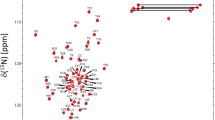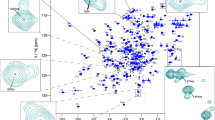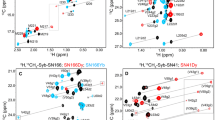Abstract
Human neuron-specific PACSIN1 plays a key role in synaptic vesicle recycling and endocytosis, as well as reorganization of the microtubule dynamics to maintain axonal plasticity. PACSIN1 contains a highly conserved C-terminal SH3 domain and an F-bar domain at its N-terminus. Due to its remarkable interaction network, PACSIN1 plays a central role in key neuronal functions. Here, we present a robust backbone and side-chain assignment of PACSIN1 SH3 domain based on 2D [1H,15N] HSQC or HMQC, and 3D BEST-HNCO, -HNCACB, -HN(CO)CACB, -HN(CA)CO, and standard (H)CC(CO)NH, HN(CA)NNH, HN(COCA)NH, HBHANNH, HNHA, HBHA(CO)NH, H(CC)(CO)NH, HCCH-TOCSY, that covers 96% for all 13CO, 13Cα and 13Cβ, 28% of 13Cγδε, and 95% of 1HN and 15N chemical shifts. Modelling based on sequence homology with a known related structure, and chemical shift-based secondary structure predictions, identified the presence of five β-strands linked by flexible loops. Taken together, these results open up new avenues to investigate and develop new therapeutic strategies.

Similar content being viewed by others
References
Anggono V, Smillie KJ, Graham ME, Valova VA, Cousin MA, Robinson PJ (2006) Syndapin I is the phosphorylation-regulated dynamin I partner in synaptic vesicle endocytosis. Nat Neurosci 9:752–760
Delaglio F, Grzesiek S, Vuister GW, Zhu G, Pfeifer J, Bax A (1995) NMRPipe: a multidimensional spectral processing system based on UNIX pipes. J Biomol NMR 6:277–293
Fdez E, Hilfiker S (2007) Vesicle pools and synapsins: new insights into old enigmas. Brain Cell Biol 35:107–115
Gao YG, Yan XZ, Song AX, Chang YG, Gao XC, Jiang N, Zhang Q, Hu HY (2006) Structural insights into the specific binding of huntingtin proline-rich region with the SH3 and W domains. Structure 14:1755–1765
Kessels MM, Qualmann B (2004) The syndapin protein family: linking membrane trafficking with the cytoskeleton. J Cell Sci 117:3077–3086
Kim WT, Chang S, Daniell L, Cremona O, Di Paolo G, De Camilli P (2002) Delayed reentry of recycling vesicles into the fusion-competent synaptic vesicle pool in synaptojanin 1 knock-out mice. Proc Natl Acad Sci 99:17143–17148
Li SH, Li XJ (2004) Huntingtin-protein interactions and the pathogenesis of Huntington's disease. Trends Genet 20:146–154
Liu JP, Zeitlin SO (2017) Is huntingtin dispensable in the adult brain? J Huntingt Dis 6:1–17
Liu Y, Lv K, Li Z, Yu ACH, Chen J, Teng J (2012) PACSIN1, a tau-interacting protein, regulates axonal elongation and branching by facilitating microtubule instability. J Biol Chem 287:39911–39924
Luo L, Xue J, Kwan A, Gamsjaeger R, Wielens J, Kleist LV, Cubeddu L, Guo Z, Stow JL, Parker MW, Mackay JP, Robinson PJ (2016) The binding of syndapin SH3 domain to dynamin proline-rich domain involves short and long distance elements. J Biol Chem 291:9411–9424
Mayzel M, Rosenlöw J, Isaksson L, Orekhov VY (2014) Time-resolved multidimensional NMR with non-uniform sampling. J Biomol NMR 58:129–139
McAdam RL (2020) Loss of huntingtin function slows synaptic vesicle endocytosis in striatal neurons from the httQ140/Q140 mouse model of Huntington's disease. Neurobiol Dis 134:104637
Miyoshi-Akiyama T, Aleman LM, Smith JM, Adler CE, Mayer BJ (2001) Regulation of Cbl phosphorylation by the Abl tyrosine kinase and the Nck SH2/SH3 adaptor. Oncogene 20:4058–4069
Modregger J, Ritter B, Witter B, Paulsson M, Plomann M (2000) All three PACSIN isoforms bind to endocytic proteins and inhibit endocytosis. J Cell Sci 113:4511–4521
Modregger J, DiProspero NA, Charles V, Tagle DA, Plomann M (2002) PACSIN1 interacts with huntingtin and is absent from synaptic varicosities in presymptomatic Huntigton's disease brains. Hum Mol Genet 11:2547–2558
Musacchio A, Wodak SJ (2003) How SH3 domains recognize proline. Adv Protein Chem 61:211–268
Qin ZH, Wang Y, Sapp E, Cuiffo B, Wanker E, Hayden MR, Kegel KB, Aronin N, diFiglia M (2004) Huntingtin bodies sequester vesicle-associated proteins by a polyproline-dependent interaction. J Neurosci 24:269–281
Qualmann B, Roos J, DiGregorio PJ, Kelly RB (1999) Syndapin I, a synaptic dynamin binding protein that associates with the neural Wiskott-Aldrich syndrome protein. Mol Biol Cell 10:501–513
Qualmann B, Koch D, Kessels MM (2011) Let's go bananas: revisiting the endocytic BAR code. EMBO J 30:3501–3515
Pieper U, Webb BM, Barkan DT, Schneidman-Duhovny D, Schlessinger A, Braberg H, Yang Z, Meng EC, Pettersen EF, Huang CC, Datta RS, Sampathkumar P, Madhusudhan MS, Sjolander K, Ferrin TE, Burley SK, Sali A (2011) ModBase, a database of annotated comparative protein structure models, and associated resources. Nucleic Acids Res 39:465–474
Rao Y, Ma Q, Vahedi-Faridi A, Sundborger A, Pechstein A, Puchkov D, Luo L, Shupliakov O, Saenger W, Haucke V (2010) Molecular basis for SH3 domain regulation of F-bar-mediated membrane deformation. Proc Natl Acad Sci 107:8213–8218
Ritter B, Modregger J, Paulsson M, Plomann M (1999) PACSIN2, a novel member of the PACSIN family of cytoplasmic adapter proteins. FEBS Lett 454:356–362
Šali A, Potterton L, Yuan F, van Vlijmen H, Karplus M (1995) Evaluation of comparative protein modelling by MODELLER. Proteins Struct Funct Bioinform 23:318–326
Shen Y, Bax A (2013) Protein backbone and sidechain torsion angles predicted from NMR chemical shifts using artificial neural networks. J Biomol NMR 56:227–241
Shen Y, Bax A (2015) Protein structural information derived from NMR chemical shift with the neural network program TALOS-N. Methods Mol Biol 1260:17–32
Vranken WF, Boucher W, Stevens TJ, Fogh RH, Pajon A, Llinas M, Ulrich EL, Markley JL, Ionides J, Laue ED (2005) The CCPN data model for NMR spectroscopy: development of a software pipeline. Proteins 59:687–696
Wang Q, Navarro MVAS, Peng G, Molinelli E, Goh SL, Judson BL, Rajashankar KR, Sondermann H (2009) Molecular mechanism of membrane constriction and tabulation mediated by the F-BAR protein PACSIN/Syndapin. Proc Natl Acad Sci USA 106:12700–12705
Wasiak S, Quinn CC, Ritter B, de Heuvel E, Baranes D, Plomann M, McPherson PS (2001) The Ras/Rac guanine nucleotide exchange factor mammalian son-of-sevenless interacts with PACSIN1/syndapin I, a regulator of endocytosis and the actin cytoskeleton. J Biol Chem 276:26622–26628
Acknowledgements
The research is supported by funding from the Métropole Européenne de Lille, through the PUSHUP project. We acknowledge LabEx (Laboratory of Excellence) for financial support on the scope of the DISTALZ consortium (ANR, ANR-11-LABX-009). The NMR facilities were funded by the Nord Region Council, CNRS, Institut Pasteur de Lille, the European Community (ERDF), the French Ministry of Research and the Université de Lille and by the CTRL CPER cofunded by the European Union with the European Regional Development Fund (ERDF), by the Hauts-de-France Regional Council (Contract No 17003781), Métropole Européenne de Lille (Contract No 2016_ESR_05), and French State (Contract No 2017-R3-CTRL-Phase1). We acknowledge support for the NMR facilities from TGE RMN THC (CNRS, FR-3050) and FRABio (Univ. Lille, CNRS, FR-3688).
Author information
Authors and Affiliations
Corresponding author
Ethics declarations
Conflict of interest
The authors declare that they have no conflict of interest.
Additional information
Publisher's Note
Springer Nature remains neutral with regard to jurisdictional claims in published maps and institutional affiliations.
Rights and permissions
About this article
Cite this article
Boll, E., Cantrelle, FX., Landrieu, I. et al. 1H, 13C, and 15N chemical shift assignment of human PACSIN1/syndapin I SH3 domain in solution. Biomol NMR Assign 14, 175–178 (2020). https://doi.org/10.1007/s12104-020-09940-z
Received:
Accepted:
Published:
Issue Date:
DOI: https://doi.org/10.1007/s12104-020-09940-z




